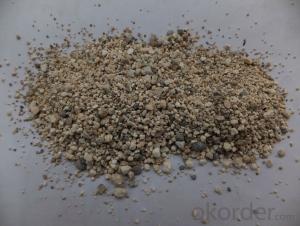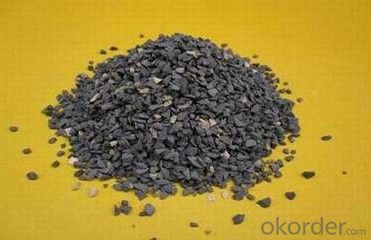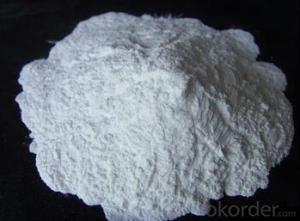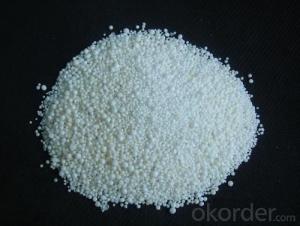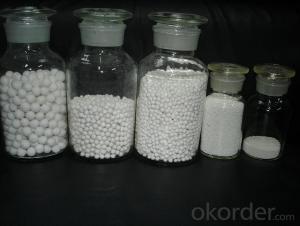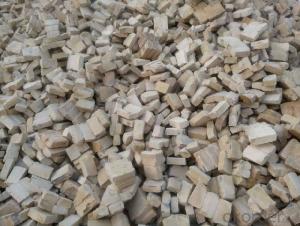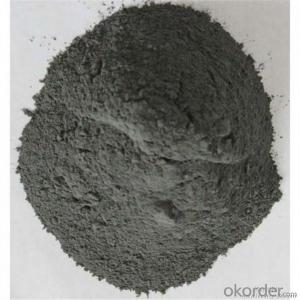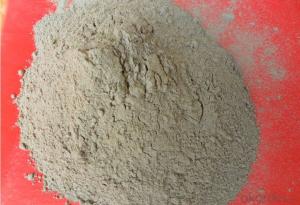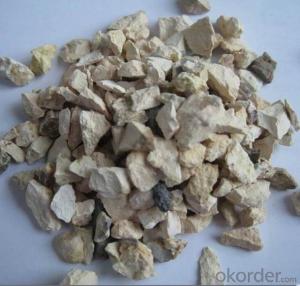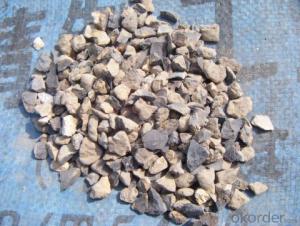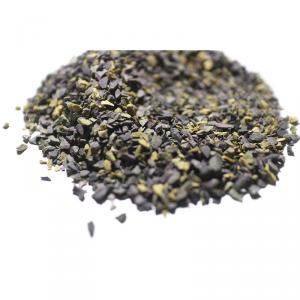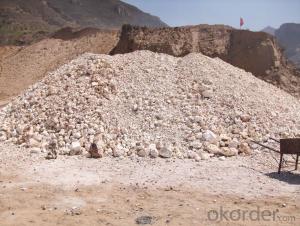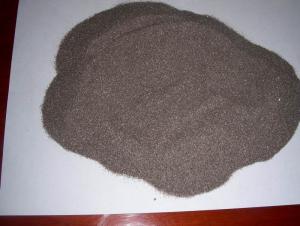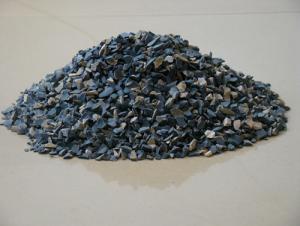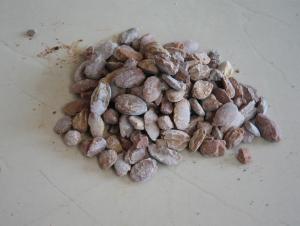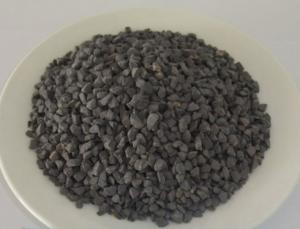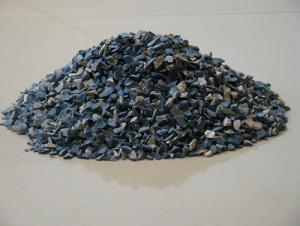Raw Materials for Refractory:Calcined Bauxite (Grade Refractory, Size 1-3mm)
- Loading Port:
- China main port
- Payment Terms:
- TT OR LC
- Min Order Qty:
- 25 m.t.
- Supply Capability:
- 20000 m.t./month
OKorder Service Pledge
OKorder Financial Service
You Might Also Like
Packaging & Delivery
| Packaging Details: | 25kgs/woven bag with PE liner bag 1000kgs in a big bag |
| Delivery Detail: | Shipped in 7 days after payment |
refractory grade size 1-3mm calcined bauxite
1. Calcined Bauxite 1-3mm brief introduction:
Calcined bauxite is a mixture of minerals that contain various concentrations of hydrated
aluminum oxides as well as impurities. The primary ore minerals are gibbsite (alumina tri-hydrate), boehmite and diaspore (alumina monohydrates).
2. Different grades calcined Bauxite 1-3mm tech datas:
Grade | AL2O3 | FE2O3 | TIO2 | K2O+Na2O | CaO+MgO | Bulk density |
75 | 75min | ≤3.0 | ≤4.0 | ≤0.3 | ≤0.5 | ≥2.70 |
80 | 80min | ≤3.0 | ≤4.0 | ≤0.3 | ≤0.5 | ≥2.80 |
85 | 85min | ≤2 | ≤4.0 | ≤0.3 | ≤0.5 | ≥3.00 |
86 | 86min | ≤2 | ≤4.0 | ≤0.3 | ≤0.5 | ≥3.10 |
87 | 87min | ≤2 | ≤4.0 | ≤0.3 | ≤0.5 | ≥3.20 |
88 | 88min | ≤1.8 | ≤4.0 | ≤0.25 | ≤0.5 | ≥3.25 |
90 | 90min | ≤1.8 | ≤4.0 | ≤0.25 | ≤0.5 | ≥3.25 |
3. Sizes available:
Grain size : 8-5mm, 5-3mm, 3-1mm, 1-0mm
powder: -320mesh, -280mesh, -240mesh, -200mesh,
-180mesh, -150mesh, -120mesh, -100mesh
320F 200F 280F 240F
200F 80F 150F 100F
4. Calcined Bauxite 1-3mm applications:
Aluminum smelting
Precision casting
Refractory products
Grinding materials
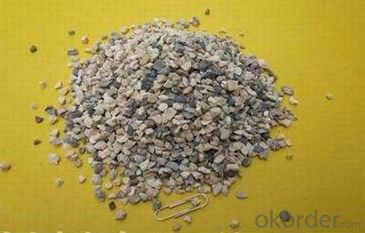
- Q: How many kinds of A-level fireproof and thermal insulation materials are there?
- Inorganic insulation materials basically can achieve the goal, such as glass wool, rock wool, and foam glass. The phenolic foam in the organic foam material is special. Phenolic foam is not only good at insulation, but also good at compounding with steel and other materials to achieve A-level performance, and the A-level insulation materials are: Rock(ore) wool, foam glass and inorganic thermal insulation mortar.
- Q: What is the function of refractory in ceramics?
- It depends on what purpose you want to achieve. At the same time, part of special ceramics belongs to refractory. If is is to produce ceramic products, the aforesaid answers are very comprehensive.
- Q: What kind of refractory materials should be used for the intermediate frequency furnace to smelt manganese?
- I’d like to make supplements to upstairs that aluminum silicate refractory materials should be needed considering heat insulation.
- Q: What are the features of construction class A fire resistant door ?
- 1, fireproof and thermal insulation Foam cement board is a Class A non-combustible inorganic heat preservation material which has good fireproof?performance can remain integrity after 3 hours baking at 1200℃. It can be used in buildings to improve fireproof?performance.
- Q: How should refractory cement be used?
- How to use refractory cement? How to use refractory cement? Thank you.
- Q: Which one is the best refractory material?
- 1, Acid refractory usually refers to the refractory material whose content of SiO2 is more than 93% , and is characterized by erosion resistance to acid slag under high temperature , but it is easy to react with alkaline slag. Commonly used acid refractory materials include silica bricks and clay bricks. 2, Alkaline refractory material is a kind of refractory material whose components are magnesium Oxide or the mixture of magnesium oxide and calcium oxide. 3, Aluminosilicate refractory refractory material refers to refractory material which makes SiO2-Al2O3 as the main component. According to the content of Al2O3, it can be divided into semi silica (Al2O3 15~30%), clay (Al2O3 30~48%), high alumina (Al2O3 > 48%). 4, Fusion-cast refractory material refers to a kind of refractory product that melt the batch through some certain methods refractory products, and then pouring into a certain shape. 5, Neutral refractory materials mean that under high temperature, don’t react with acidic or alkaline slag. 6, Special refractory material is a new type of inorganic nonmetal material, which is developed on the basis of traditional ceramic and refractory materials. 7, The amorphous refractory material is a mixture of refractory aggregate and powder, binder or admixture, which can be used directly or after adding the appropriate liquid mixing.
- Q: How many refractories are there for boiler above 1200 ℃?
- Ordinary clay brick is for burning layer, red brick for external wall, light clay brick for thermal insulation layer, built by clay refractory mortar. Sindeyuan Refractories.Hope you adopt. Thank you. In fact, there are many manufacturers producing furnace burden. We has been using products of Huaheng, which are anti-erosion, easy to construct and can improve production efficiency, reduce steelmaking cost.
- Q: Why should graphitic refractory materials be used now that graphite can burn?
- Materials for refractory must have the following characteristics and properties: 1, high stability: Anti-oxidation, anti-reduction, thermal decomposition; 2, high melting point : 2800℃; 3, low price. Graphite has all three characteristics and properties, especially melting point and stability.
- Q: Can polystyrene foam color steel plate be used as decorative fireproofing material ?
- No, only non-combustible product can prevent fire. Most polystyrene foam boards are flammable which cannot prevent fire. Polyphenyl can only retard flame, highest fire?retardant fire?rating being B1 level. Under the same conditions, fireproof performance of polystyrene foam board will be better because most extruded sheets are made by recycling materials and contain much more impurities which will affect flame resisting property. The second reason is that high temperature in extruded sheet manufacturing technique will decompose part of flame retardants. For B1 level extruded sheet, it is difficult to reach 30 burning oxygen index, while for B2 level, it is hard to reach 32. So polyphenyl board is safer.
- Q: What level is the rock wool board fireproofing material ?
- The fire rating classification is a provision for all insulation materials, rather than to separately divide rock wool. Determine the value of the material fire rating according to the relevant test items of 8624. As the rock wool is made from basalt fusion, so it is the level A non-combustible material.
Send your message to us
Raw Materials for Refractory:Calcined Bauxite (Grade Refractory, Size 1-3mm)
- Loading Port:
- China main port
- Payment Terms:
- TT OR LC
- Min Order Qty:
- 25 m.t.
- Supply Capability:
- 20000 m.t./month
OKorder Service Pledge
OKorder Financial Service
Similar products
Hot products
Hot Searches
Related keywords
